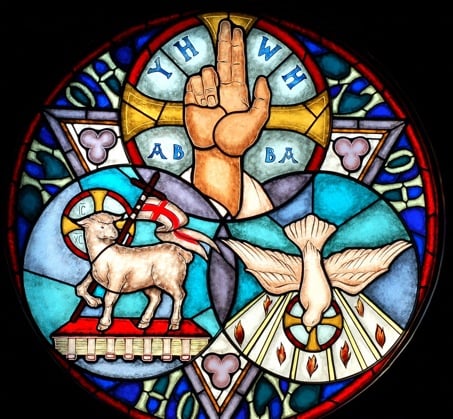Jesus' Garment
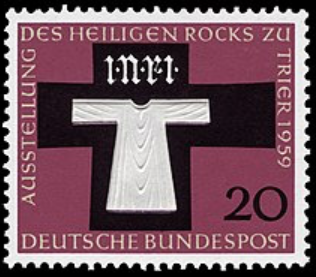
Introduction
In Ecce Homo I displayed an illustration of the male child, hidden within a 3D cross unfolding from a tesseractoid that is the true Ark of the Testimony. This tesseractoid, a 4D analogue of a cuboid, emerged from numbers and symbolism built into the Biblical Ark, which had been encoded to imply this construction.
Here, I would like to continue our journey to the Cross/Ark by showing how the model of an unfolding tesseract recapitulates and expands on the symbolism of the Hebrew characters chet, zayin and vav, a story I began in The Staff and the Crown and The Throne of God.
The story centres on Jesus' death on the Cross.
Jesus' Undergarment
Here is John 19.23, which I quoted near the end of the previous page. It concerns Jesus' seamless undergarment and it guided me to the final revelation on that page about the divine origin and identity of the male child. It is also marked with a number.
| When the soldiers crucified Jesus, they took his clothes, dividing them into four shares, | |
| one for each of them, with the undergarment remaining. | |
| This garment was seamless, woven in one piece from top to bottom. |
The ordinal value of the verse is 2032, which is 1016 x 2.
John 19.23 (o) = 2032 = 1016 x 2
John 19 is also the 1016th Bible chapter, so the number 1016 is being highlighted here.
Geometrically, 1016 is a star tetrahedron, but less well-known is that it is also a cubic shell - a kind of 'seamless' garment, since it is all in one piece. This 'garment' surrounds cube 1728 (12 cubed) to create cube 2744 (14 cubed). Shell 1016 is therefore also a kind of Most Holy Place (which essentially was a cubic shell too) with the Ark replaced by cube 1728.
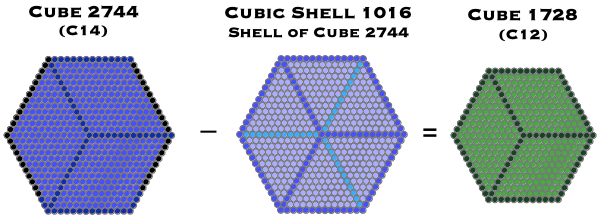
12 represents perfect government in the Bible, so 1728, as 12 cubed, is its highest terrestrial expression. This points directly to the New Jerusalem, which is marked with twelve like no other location, for example being 12,000 stadia on a side (Rev 21). The seamless undergarment in John 19.23, then, refers not just to the 3D cross that held the male child but to this garment, symbolically enclosing the New Jerusalem.
The cube created has 14 units along its edges, a number that is an integral part of the New Testament's opening verses. These concern the genealogy of Jesus and list Jesus' ancestors in three sections, with fourteen generations in each. I will just give the last verse of the list, Matt 1.16, and the summary in Matt 1.17.
| 16 and Jacob the father of Joseph, the husband of Mary, of whom was born Jesus, who is called Christ. |
| 17 Thus there were fourteen generations in all from Abraham to David, |
| fourteen from David to the exile to Babylon, |
| and fourteen from the exile to the Christ |
There's a lot of interest here, for example,
1. Matt 1.17 summarises the list and three times mentions the number 14. This gives the dimensions of a cube: 14 x 14 x 14.
2. Matt. 1.16 echoes 1016, the units in the encoded shell of the cube of 14. The gematria (ordinal) of the verse is 625, the fifth tesseract number.
3. Isaiah 11.2 describes the Messiah as having the spirit of wisdom, counsel, power, knowledge and understanding resting on him.
| Our Messiah Appearing (s) | = 1016 |
| Wisdom Appearing (s) | = 1016 |
| Cornerstone Appearing (s) | = 1016 |
Jesus is also known as the cornerstone (Psalm 118.22, etc) - and this hints at the Temple, which replaced the Tabernacle but had the same function.
4. The Bible's 1016th chapter is John 19, which contains the final account of Jesus' crucifixion - one of the two main themes being explored here! - in John 19.19:
Pilate had a notice prepared and fastened to the cross. It read: JESUS OF NAZARETH, THE KING OF THE JEWS
John 19.19 (o) = 891 = 81 x 11 = 9 x 9 x 11
81 is the ninth square and third tesseract number. 11, reduced value of 'Jesus' and 'beast', also refers to 9/11. The Superscription itself is the main interest here though, which emphasises the link between Jesus and the very concept introduced in the Gospel of John: the Word:
JESUS OF NAZARETH, THE KING OF THE JEWS (o) = 373
Logos/Word (s) ...............................................................= 373
Golgotha (o) ...................................................................= 373
The Creation Seal and the Tesseract of 7
Cube 2744 can be rearranged into a 3D cross, made from eight cubes of 343 spheres (7 cubed). As noted in these pages, a 3D cross unfolds from a tesseract [3] The tesseract of 7 is 2401, a number found in the Creation Seal. Here is the Creation Seal again, showing how the tesseract of seven is encoded.
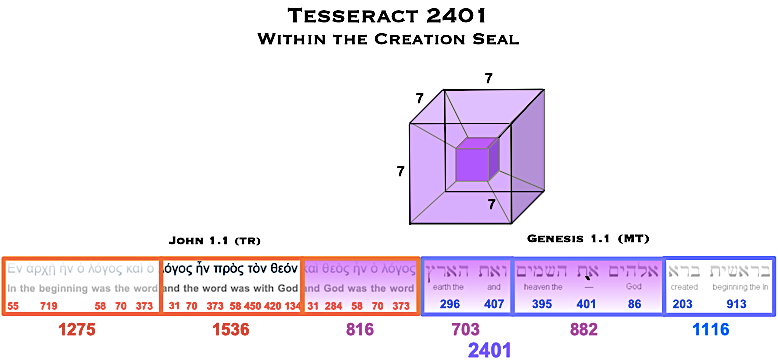
Here is a list of the tesseract's vital statistics, with some notes.
| Tesseract 2401 | (7^4) | |
| Property | Number | Quantity |
| 4D Hypervolume | 1 tesseract. | 2401 quartic units |
| 3D Volume | 8 cubes | 2744 cubic units |
| 2D Surface Area | 24 sides | 1176 square units |
| 1D Edge Length | 32 edges | 224 units |
| 0D Corners | 16 corners | 16 (dimensionless). |
1. The surface area of the tesseract is 1176 sq. units. This is the standard value of the Greek phrase found in John 1.14, meaning 'only begotten son', along with a title in modern English that we have already seen and which is particularly apt for a geometric construction:
| monogenes hulos/only begotten son (s) | = 1176 |
| The Cornerstone (c) | = 1176 |
1176 is also the 48th triangular number (T48).
Son (o) = 48
2. The edge length is 224 units. This is the Hebrew gematria of 'my spirit', first found in Genesis 6.3, when God said "My Spirit will not contend with man forever.".
Ruhi/My Spirit (s) = 224
3. The volume of 3D cross 2744 is 8 x 343, so the 3D cross this tesseract unfolds into is made of eight cubes of 343 spheres, 343 being the ordinal value of Matthew's Superscription. This then projects a cross of 294 square units (or counters for a pixellated representation). All three images are displayed below, along with the identities they represent.

So all three figures are related to Jesus Christ through gematria. On top of that, Jesus is connected through gematria to seven (Biblical number of spiritual perfection):
| Christ (o) | = 77 |
| Our Lord (c) | = 777 |
| Lord (o) | = 7 x 7 |
| THIS IS JESUS, THE KING OF THE JEWS | = 7 x 7 x 7 |
4. Two stunning encodings within the word string in the Creation Seal emphasise the connection between tesseract, Crucifixion and Christ's return.
Note that the two verses forming the Seal, Genesis 1.1 (MT) and John 1.1 (TR), have been divided here into three word groups each, based on natural textual divisions. The main encoding covers three of those groups.
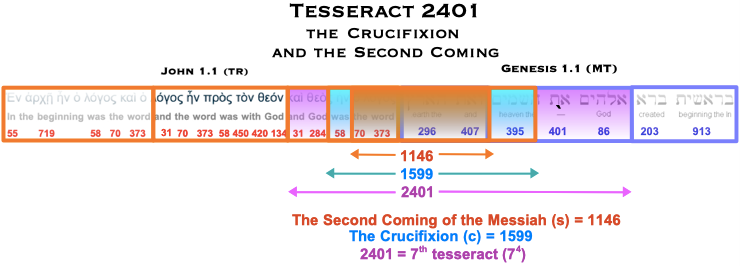
Finally, a neat little encoding relating cube 2744 to the tesseract is found in Song of Songs 5.10. Bear in mind that 10,000 is also a tesseract number (10^4).
"My lover is radiant and ruddy, outstanding among ten thousand."
Song of Songs 5.10 (o) ..........= 631
631 is the 14th hexagon, which is the diagonal projection of cube 2744 onto a flat surface!
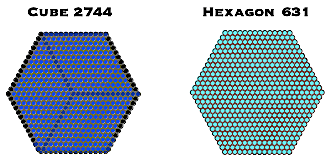
It is also the smallest hexagon that can hold the Logos Star, snowflake 373.
TheThree Hebrew Characters
In The Throne of God we saw how Jesus is symbolised by the Hebrew character zayin, the crowned man (vav), with numeric value 7, representing spiritual perfection.
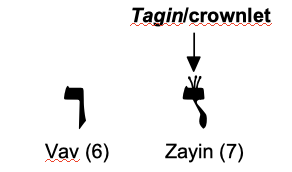
In Isaiah 53.12 and Luke 22.37 we learn that Jesus was 'numbered with the transgressors', man the transgressor having the number six (vav), because he was created on the sixth day. This identification was necessary for Jesus to atone for man's sin. The crowning, symbolised by seven (zayin) happened just before Jesus' crucifixion and the code turns this mock ceremony on its head and shows how it was in spiritual terms a real crowning and that Yeshua was no pretender but really was the King of the Jews and Mashiach. This is detailed in The Staff and the Crown.
The above encoding in the Creation Seal - bringing together the highest expression of 7 (7 x 7 x 7 x 7) with the Crucifixion and its zayin symbolism - is a recapitulation of the same message, that the mock ceremony was at a deeper level a recognition of Jesus' inherent nature: the man who was born to be King.
In Ecce Homo I showed how the Crucifixion and the Atonement Ceremony were geometrically related and that the Crucifixion reached back to the beginning of Creation itself, with Jesus being "the Lamb slain since the creation of this world." (Rev 13.8). The structure of the Ark, extended according to an encoding in Bible's first verse, along with the three sacred objects held in the Ark, symbolised four spatial dimensions and contained the blueprint for creating a geometric model of the male child.
The Ark's four-dimensional nature is quickly summaried below.
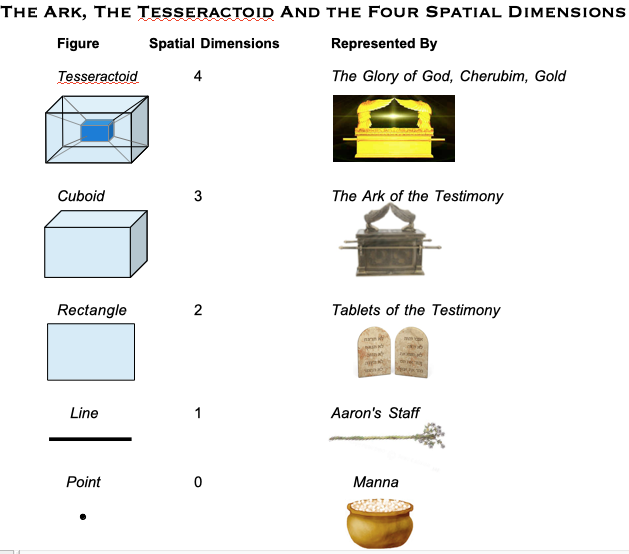
Covering Man's Sin
That Jesus had an undergarment suggests he wore other garments. In John 19.23 the soldiers divided up Jesus clothes, apart from his undergarment, again implying that he wore further layers of clothing, this time right up to his Crucifixion.
So let us clothe Jesus in a second garment.
Putting a shell over the cube of 14 builds it up to the cube of 16, 4096, which requires 1352 spheres. Incredibly, this is the standard value of the very event this page is discussing!
The Crucifixion (s) = 1352
Surrounding cube 2744 with this larger cubic shell creates cube 4096, which is sixteen cubed.
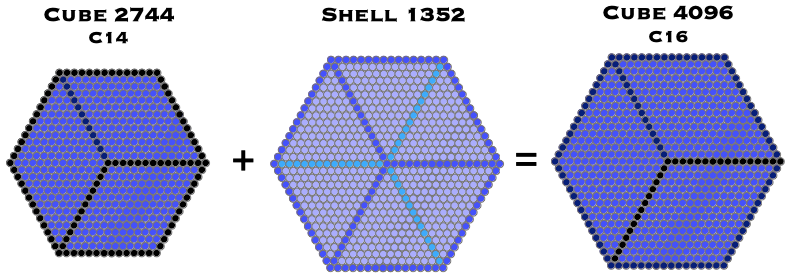
The two garments together make a double cubic shell, with 2368 spheres, the well-known value for 'Jesus Christ' in Greek! This double shell surrounds cube 1728, representing the New Jerusalem. [2]
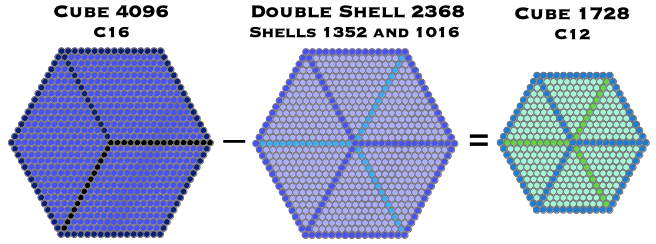
![]()
| The Crucifixion (s) | = 1352 |
| Our Messiah + Appearing (s) | = 1016 |
This again brings together the two biggest themes in the code, the Crucifixion and the Appearing of Christ, an image of the crucified Lord surrounding the New Jerusalem.
To understand the symbolism here we turn again to the Hebrew alephbet and the characters, vav, zayin and chet. Chet is composed of a vav yoked to a zayin. Individually, they sum to 13, the number of rebellion. But joined they make a chet, with numeric value 8.

As E. W. Bullinger showed, the number the number thirteen is associated with rebellion against God, whereas eight is associated with obedience to God's will and is a picture of the zayin as the Messiah, with the vav showing his disciples yoked to him. Importantly, though, the eight only applies after death, as Bullinger also showed us, and in fact eight is the Biblical number of new beginnings and superabundance. This points to Jesus as the Crucified and Resurrected Lord, the Logos leading Christians to salvation. The chet also shows Jesus as the Gate to Life (John 10.9), which began as the door frames the Israelites used a lamb's blood to redden, to protect their firstborn from the angel of death, still celebrated at Passover. So Jesus as chet is the doorway to life. The Hebrew word 'chet' sounds like the Hebrew word for sin. So we also have the idea of Jesus as the one who bore our sins on the Cross. [4]
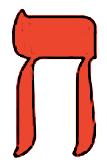
This is Jesus wearing his scarlet robe as the lamb who was slaughtered and also the second covering over the tabernacle, which was ram's hide coloured red.
Chet is numbered eight, which has a profound link to the number 4096, because in addition to being the cube of 16, 4096 is the tesseract of 8. This is encoded within the three-part seal I call the New Garden of Eden, which is the Garden of Eden (Genesis 1.1-5, NIV) added to the Creation Seal.
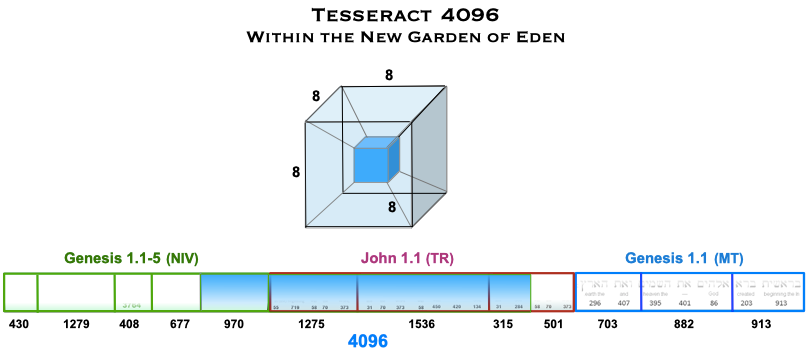
We now have the tesseract of 8 to add to the tesseract of 7, both encoded near the centre of the three-part New Garden of Eden.
Inside the blue word strong is a number I feature in The Lock and the Key, and found in Revelation 21.6.
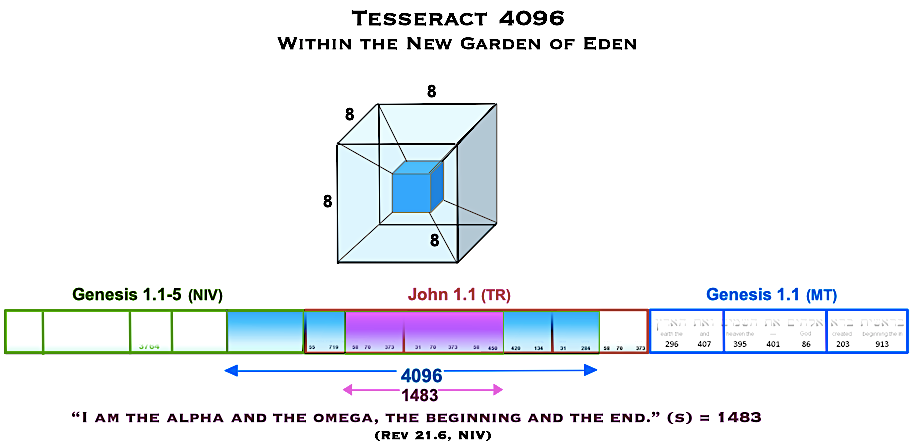
The number 1483 is also the standard value of these phrases, which combine with the above identity to put a divine seal of authority on this dazzling gem of a code.
| The Key to the Code ( s) | = 1483 |
| aneochthe/was opened (s) (Luke 1.64) | = 1483 |
Here are the two tesseracts together, overlapping at the number 315 in John, which is 'and God'.
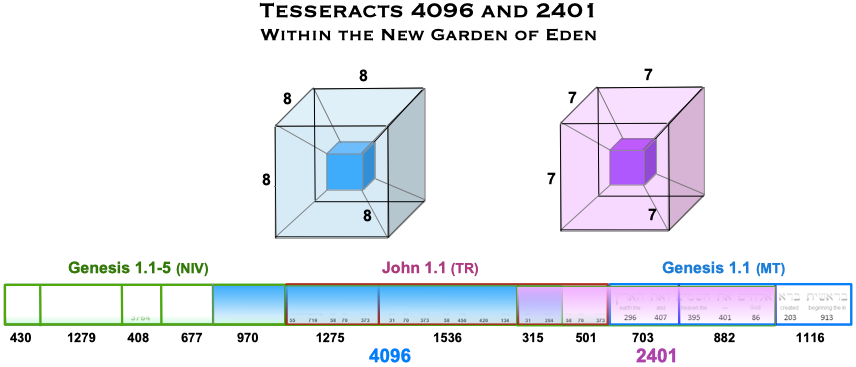
This puts a Divine seal on the message delivered in this page and in The Throne of God about the deeper meaning of Jesus mock crowning and Crucifixion: it was his literal crowning as Messiah and King. After shedding his blood on the Cross, Christ was resurrected to become the Risen Lord and now stands as the Gate to Life.
The same story is told by the Hebrew letters zayin (7) and chet (8), and reiterated by the presence of the tesseracts of 7 and 8, also representing the higher dimension of heaven, the Kingdom of God, which, like Jesus seamless undergarment, literally is all around us.
Appendix: The Divine Tesseract
4096 has numerical properties that make it unique among the tesseracts and worthy of our attention simply as a mathematical object. For example, it is also a square and a cube (as well as higher dimensional polytopes).
| 4096 | = 8 x 8 x 8 x 8 |
| 4096 | = 16 x 16 x 16 |
| 4096 | = 64 x 64 |
Here are its vital statistics.
| Properties of Tesseract 4096. | Number of units | Geometry |
| Tesseract (4D) | 4096 | 8th tesseract number |
| 8 3D cubic 'envelopes' | 4096 | 8th tesseract number |
| 24 2D surfaces | 1536 | 2D cross, crown |
| 32 1D edges | 256 | 4th tesseract number |
| 16 0D corners | 16 | 2nd tesseract number |
Three of its structural properties are tesseract numbers in themselves! The other number, 1536, is no less than the Crown of Thorns, setting for the Jewel. Within the Jewel is hexagon 721, representing the Voice of God and the projection of cube 4096. The geometric integration between different Bible passages is incredible and speaks of design at the highest level.
Bill Downie 5/11/22
Notes
1. This is an unusual procedure, but although gematria is very precise, there also seems to be a degree of creativity involved too, whenever extra information can be packed into these numbers and images and circumstances lend themselves to it. The way the code works seems to resemble recreational mathematics, at times, and in fact I believe it is the very highest form of re-creation, with great seriousness of purpose, yes, but an equally great sense of joy, delight and storytelling.
2. This was found by Vernon Jenkins.
3. Strictly, we are considering a hollow tesseract here. Just as a hollow cube still has a surface, so a hollow tesseract filling 4096 quartic units of hyperspace still has this cubic envelope. The empty 4D hyperspace inside has an edge of 8 units, which gives the hypervolume of the tesseract of 8 x 8 x 8 x 8, or 4096 quartic units.
4. https://www.thelivingword.org.au/grand-design/session26.php
